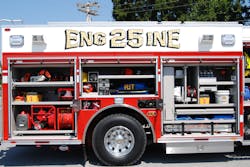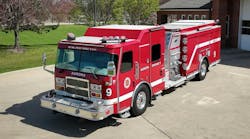Over the years, most pieces of fire apparatus, regardless of type, have become larger. Basic dimensions such as overall length, overall height and the in-service weights of units have become so large that in some instances the physical size of the vehicle has made it difficult to work from with some tools and equipment literally out of reach of the average-size firefighter.
We can all probably remember a piece of apparatus that was on display at a fire show and thought to ourselves, “Why on earth did they do that”? The level of customization on fire apparatus depends in large part on the perceived needs of the department and the ability of manufacturers to develop new and innovative components that catch our attention.
While not meant to demean their capabilities on the fireground, combination apparatus such as rescue engines and quints have fostered the concept that departments can combine components, tools and equipment into one vehicle that will bring the entire toolbox to an incident. As a result, many all-hazards agencies have embraced the multi-purpose apparatus as the answer to their needs to carry the majority of their equipment on a single unit. The issue becomes one of when does a piece of apparatus become too large and cumbersome to operate, either within the first-due area or in neighboring jurisdictions?
In “The Apparatus Architect – Part 45” (April 2010), we discussed a trend in some areas of the country to return to smaller mini-pumper-size engine apparatus in a “back-to-basics” approach to providing both first-response and suppression services for the community. In many communities, the square footage of homes is greater than that of some commercial strip stores. While the magnitude of the fire potential at these locations has increased dramatically, roadway access for fire apparatus is very limited, particularly in some private gated subdivisions. More than ever, apparatus committees must evaluate the service needs of their first-due areas and temper this with practical application of situational awareness to provide for well-designed apparatus.
National Fire Protection Association (NFPA) 1901, Standard for Automotive Fire Apparatus, in Table 12.1.2 provides excellent guidance as to the minimum equipment payload weights that should be considered for the various types of apparatus. For pumpers with enclosed compartment space of less than 250 cubic feet, the minimum equipment allowance is 2,000 pounds and increases to 2,500 pounds for larger bodies. As these payload allowances are a minimum, the fire department must clearly identify their requirements for hose, tools and appliances when developing their specifications. Unfortunately, there are many pieces of apparatus operating today that are overloaded as the equipment complement was not specified and over time, additional tools are mounted on the apparatus, which can result in poor braking and vehicle performance. Overweight apparatus have become a fire service plague. In recognizing this, the NFPA now requires all fire apparatus to be weighed annually.
During the specification-development process, the apparatus committee, after determining the mission of the apparatus, should review the tool and equipment requirements, starting with an inventory of existing apparatus. While NFPA 1901 lists basic equipment requirements for engine, ladder and special-service units, this equipment loading typically does not capture all of the tools and appliances that departments will require on front-line units. For example, it is one thing to call for a hydraulic rescue tool compartment to include reels and sufficient slide trays to accommodate fire department-supplied equipment and another to detail the specific make, model, size and weight of this equipment to ensure that sufficient compartment space and weight are available to safely carry these tools. Also, make sure to allow space for any mounting brackets along with the tool itself.
Most apparatus manufacturers have developed standard body designs with specific compartment dimensions based on the capacity of the water tank and hosebed to provide different lengths in order to meet fire department needs. The apparatus committee should inquire as to the various options to determine the best match for the overall length of the body and how this may impact the wheelbase and turning radius for the completed unit.
Often, departments simply choose the largest body available and then work backwards to make the tools and equipment fit within the allocated space. This often results in mega-sized apparatus that carry everything, but do not allow access to tight areas within a community or simply cannot maneuver in locations where older vehicles could easily fit.
When reading through manufacturers’ specifications, remember that all dimensions are not necessarily equal. Some specifications state the overall compartment dimensions in inches for the height, width and depth of each area. These numbers, while impressive, may not take into consideration the loss of height due to headers or the roll-door shutters and the clear-door opening past hinged doors or trim pieces. In addition, the depth of each compartment should be the clear useable space for equipment storage with the door closed. The use of slide-out trays for easier access to equipment must allow not only for the height of the slide mechanisms and thickness of the tray itself, but the side clearances required to pass through the door opening. Some of these dimensions are normally not provided in specifications provided by the apparatus manufacturers and must be determined after consultation with sales and engineering personnel.
After the specific compartment dimensions are established, you can begin to lay out your tools and equipment within each compartment area. If you had already developed the apparatus inventory of equipment, including dimensions and weights, there are several methods that you can use to lay out each compartment shelf, tray and tool board space. Several manufacturers and equipment mounting companies can provide a computer-aided design (CAD) drawing for each area within the compartment body. These CAD drawings can be of great assistance to determine ahead of time, before any metal is sheared, to ensure that your equipment can be safely mounted in each location.
Another technique that can be accomplished in the fire station is to mark out on the apparatus bay floor with tape each surface area such as an adjustable shelf, tray or wall area and locate the desired equipment within the space. Documentation of this work should include digital images and a listing of the appliances and equipment for each location. Still other fire departments have built wooden compartment mockups with the exact dimensions of each compartment.
The upfront work conducted at this point in the design process can alleviate some of the issues that crop up later and can cost a great deal of time and money to solve once the apparatus goes into production. This work is particularly important if your department is working on the design for an apparatus that will combine the equipment from several pieces of apparatus into a single unit. The apparatus manufacturer will be able to validate your requested tool and equipment locations while providing an accurate analysis of the anticipated in service weight of the apparatus prior to construction. Failure to provide this level of detail during the design phase can lead to unbalanced side to side weight or overloaded apparatus, which in some cases cannot be easily modified to ensure a safe vehicle. The work the apparatus committee does in the beginning pays big dividends at the end of the project, especially when your apparatus committee goes to do the all-important final inspection.
While tool and equipment mounting is one of the last items to accomplish prior to placing the unit into service, consideration must be given to how this work is going to be conducted. Some departments have historically left this work to individual fire companies with mixed results. Others have tasked this work to be conducted by the department shops and mechanics to provide some standardization in tool and equipment placement.
With the financial restrictions placed on maintenance budgets and capital expenditures, many municipalities have diminished resources to provide this work. Apparatus committees should consider including a specific amount for tool and equipment mounting into the final specifications to ensure that the complete inventory of tools and equipment will be properly and safely secured in the cab and body compartments. A statement similar to the following could be included: “Each bidder shall include an amount of $7,000 for tool and equipment mounting of fire department-supplied equipment, including hydraulic rescue tools as listed in the attached specifications. The tool mounts whether custom-fabricated or commercially purchased hardware shall be approved by the fire department.”
When working on new-apparatus specifications, the department should develop a complete equipment inventory, plan the space allocation needed to safely accommodate and secure this equipment, and not fall into the common trap of acquiring the largest body style available with the hope that everything will work out. Considering the life cycle of the apparatus with leaving some open space for future equipment, the cost of tool and equipment mounting is nominal when compared to some of the more costly components that are installed on new units. The days of taking equipment off old apparatus and trying to find a place for it on the new apparatus have to be over, especially given the cost of the apparatus and how costly a mistake could be.






